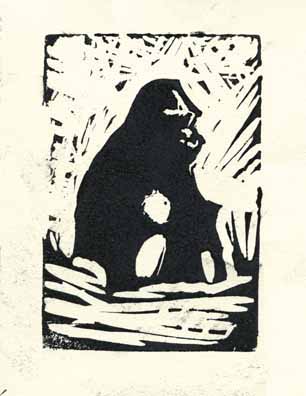Gorilla - Block Print

Until the advent of the digital age, image reproduction was - as Cuban journalist José Martí might have said - una piedra en el zapato. Even with automatic engraving machines that appeared in the 20th century to produce halftone plates, the process at best took hours. In the 19th century it was really a pain. Eventually photoengraving allowed reproduction of photographs without the need for sweatshops of apprentice engravers and the images were faithful reproductions of the photos, but it was a far cry from making copies on your computer.
But the earliest of all image reproduction methods was block printing of which this is an example. The picture would be drawn on a block (usually of wood) and the part of the wood that was not to appear as a dark area or line was cut away. Inking the raised areas and then pressing paper on the inked block produced the image on the paper. Block printing therefore differs from intaglio etching where the dark areas and lines are etched into the plate and the excess ink wiped from the surface. The intaglio prints therefore require wetted paper and specialized high pressure presses so the paper is forced into the etched areas to pull the ink from the plate. Block printing does not require the specialized presses, and in fact, does not require actual presses at all. The drawback is that you have to think in reverse - you cut away the areas you don't want to print. It can also be a very laborious process.
Wood block prints are not to be confused with wood block engravings. Wood blocks for prints are usually cut on the broad side of a wooden plank. As are result the grain of the wood affects the way the picture can be carved and so the block prints generally are not highly detailed. Thin lines are rare on wood blocks which tend to be of more abstract images.
A wood engraving, on the other hand, is made from a wood block where the surface is from the end grain of the wood. So rather than cut the tree lengthwise to get planks of wood, you cut cross sections. These sections are then shaped into the squares or rectangles. So wood engravings tend to be smaller than block prints, but if you need a large engraving, smaller blocks are glued together. Naturally engraving blocks are quite a bit more expensive than those used for block prints, but the advantage is the grain of the wood has less of an effect on the engraving process and the engravings can show much finer detail.
Among the most famous wood engravings are those which appeared in the books by the Charles Lutwidge Dodgson (ergo, Lewis Carroll) - Alice's Adventures in Wonderland and Through the Looking Glass. The wood engravings were by the Daziel Brothers, George, Edward, John, and Thomas (that's John and Thomas, not John Thomas), as well as by their sister Margaret. The prints in the Alice books were made from the drawings of Sir John Tenniel. The artists themselves did not make the actual wood engravings.
Some of the artists, though, worked closely with the engravers. Both Sir John and the American artist Winslow Homer could adapt their style to the special requirements of black and white printing and so made the engravers' jobs easier. Sir John and Winslow would sometimes even draw directly onto the wood blocks. Usually, though, the drawing would be copied or otherwise transferred to the block by an staff artist. And it is worth emphasizing to those who attend exhibits of wood engravings of Sir John and Winslow that they did not do the engraving or printing themselves.
So who was the actual artist? The prints themselves constitute works of art in their own right and a good deal of the appreciation is for the skill required to produce the fine details by hand in carving the blocks. In fact, the Daziel Brothers themselves would say they employed the artists, not only Sir John, but also Frederic, Lord Leighton, Sir John Everett Millais, and Dante Gabriel Rossetti (who had trouble adapting his style for wood engraving). As a result the Daziel brothers and Margaret often referred to the artists as (ptui) "designers" while they saw themselves are the true artists.
Ironically, the style of drawing that was suitable for wood engraving is ideal for images in the small hand-held electronic devices so popular today. So the electronic editions of old 19th century and early 20th century art instruction books - which relied on wood engravings - are sometimes more useful that the E-editions of later larger and more "modern" tomes.
Lest the connoisseur sneer at the lack of artistry displayed in this print, this was cut fairly quickly from an image drawn freehand directly on the block. It was a test print intended to map out the general picture for what will (possibly) end up as a monoprint or as part of a monotype. At the same time, as is common, the quick sketch probably looks better than the "final" work will.
References
"Alice's Evidence", Woodcut proof by the Daziel Brothers based on a drawing by Sir John Tenniel, The British Museum, http://www.britishmuseum.org/explore/highlights/highlight_objects/pd/s/sir_john_tenniel,_alices_evide.aspx
"Winslow Homer, the Illustrator: His Wood Engravings", The Fresno Metropolitan Museum, http://www.tfaoi.com/aa/5aa/5aa186.htm